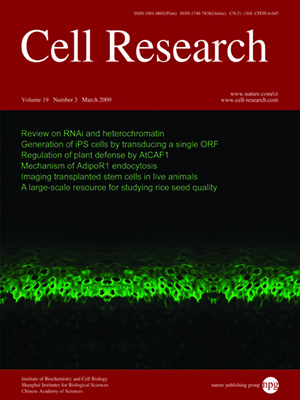
Volume 19, No 3, Mar 2009
ISSN: 1001-0602
EISSN: 1748-7838 2018
impact factor 17.848*
(Clarivate Analytics, 2019)
Volume 19 Issue 3, March 2009: 296-306
ORIGINAL ARTICLES
Generation of iPS cells using defined factors linked via the self-cleaving 2A sequences in a single open reading frame
Lijian Shao1,*, Wei Feng1,*, Yan Sun1, Hao Bai1, Jun Liu1, Caroline Currie1, Jaejung Kim2, Rafael Gama2, Zack Wang1, Zhijian Qian3, Lucy Liaw1 and Wen-Shu Wu1
1Center for Molecular Medicine, Maine Medical Center Research Institute, 81 Research Drive, Scarborough, Maine 04074, USA
2Functional Genomics Facility, Division of Biological Science, the University of Chicago, Chicago, Illinois 60637, USA
3Section of Hematology/Oncology and the Cancer Research Center, the University of Chicago, Chicago, Illinois 60637, USA
Correspondence: Wen-Shu Wu,(wuw@mmc.org)
Generation of induced pluripotent stem (iPS) cells from somatic cells has been achieved successfully by simultaneous viral transduction of defined reprogramming transcription factors (TFs). However, the process requires multiple viral vectors for gene delivery. As a result, generated iPS cells harbor numerous viral integration sites in their genomes. This can increase the probability of gene mutagenesis and genomic instability, and present significant barriers to both research and clinical application studies of iPS cells. In this paper, we present a simple lentivirus reprogramming system in which defined factors are fused in-frame into a single open reading frame (ORF) via self-cleaving 2A sequences. A GFP marker is placed downstream of the transgene to enable tracking of transgene expression. We demonstrate that this polycistronic expression system efficiently generates iPS cells. The generated iPS cells have normal karyotypes and are similar to mouse embryonic stem cells in morphology and gene expression. Moreover, they can differentiate into cell types of the three embryonic germ layers in both in vitro and in vivo assays. Remarkably, most of these iPS cells only harbor a single copy of viral vector. This system provides a valuable tool for generation of iPS cells, and our data suggest that the balance of expression of transduced reprogramming TFs in each cell is essential for the reprogramming process. More importantly, when delivered by non-integrating gene-delivery systems, this re-engineered single ORF will facilitate efficient generation of human iPS cells free of genetic modifications.
Cell Research (2009) 19:296-306. doi: 10.1038/cr.2009.20; published online 24 February 2009
FULL TEXT | PDF
Browse 1933


